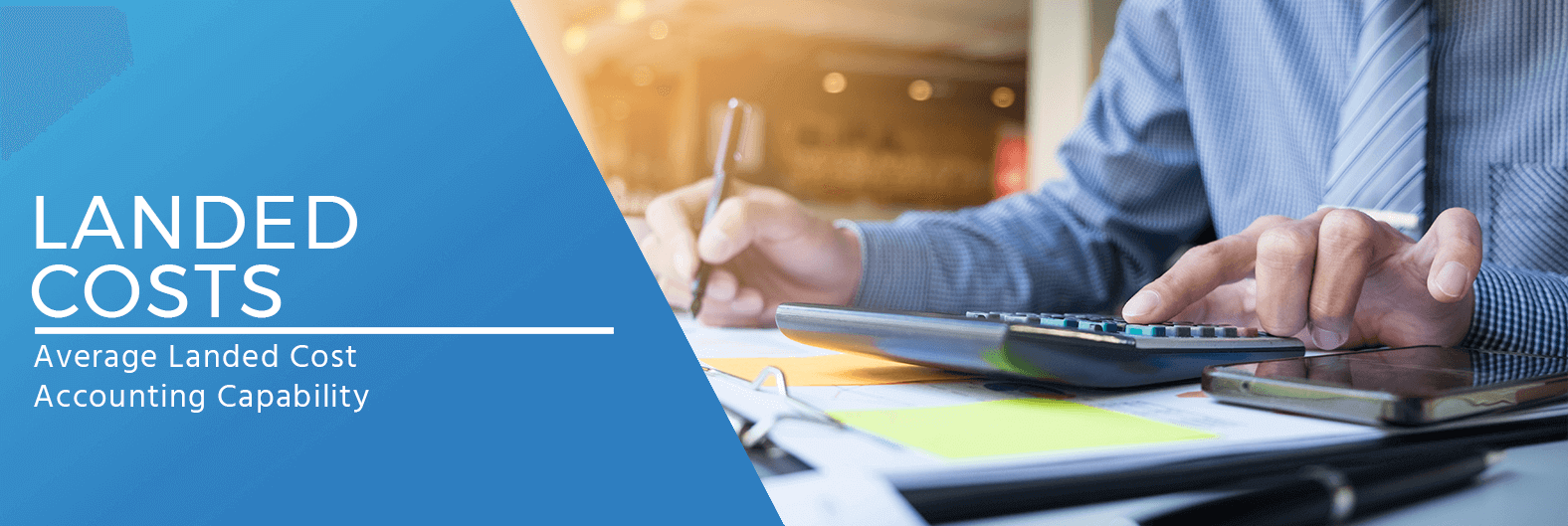Landed Costs


Finale Inventory Can Help Track Landed Costs
Accurately calculate landed costs of products with Finale Inventory. Understanding the product landed cost is essential for retailers looking to understand their gross margin and to ensure accurate profit analysis especially if you are obtaining your product overseas. Landed costs can easily be overlooked or not even considered until later on in the reporting process. By understanding the landing costs, it can help to make sure item are appropriately priced to be profitable after calculating the desired margin.
As well as the actual cost price paid to the supplier, there may be other direct costs that need to be included in your profit calculations. Import duty, freight, and insurance are all examples of direct costs that need to be taken into account when calculating the gross margin. They are not as straightforward as the actual cost price paid to the supplier though as they frequently apply to a container rather than an individual product.
You need to make a decision about how best to split container-wide costs between the different units in that container and then be able to calculate and keep track of the landed cost or the true cost per unit.
With Finale Inventory, you can allocate the other direct costs using four different methods:
- Order item quantity
- Order item weight
- Order item subtotal
- Order item cubic meters (CBM)
Understanding the gross margin means that you can work out at what point you break even, and then how much profit you'll earn after you’ve reached your break-even point. Knowing the landed cost provides you with an accurate gross margin on every unit of stock, which then allows much more accurate reporting and data that can be relied on to make key business decisions. Landed costs allow you to start adding those additional costs to your products, building up the cost price, allowing you to see a more accurate margin, and allowing your sales team to see what prices can be offered to customers.
Leveraging the landed cost calculation, Finale’s inventory accounting functions and reports complete the full picture by providing a record of each financial transaction to ensure accurate reporting of figures for financial reports, taxes, or regulatory compliance. Finale accounting reports take the guesswork out and will provide reports that your accountant or CPA can easily comprehend.
Landed Cost Calculation Example
Let’s say, for example, you run a clothing company that’s based in the United States, and you create a purchase order for 500 pairs of jeans from a Chinese supplier. The jeans cost you $20 per unit, which comes to a total of $10,000. The duty is two percent, the freight for the shipment costs $800, and insurance costs $500. An import tax of 10 percent is charged on the final value of the imported goods.
Before you calculate your landed costs, you should ensure all currencies are converted to your local currency — in this case, the United States dollar (USD). Remember to take into account the exchange rates you’ll receive. Then, you can add up your costs.
- Total product costs: 500 units times $20 equals $10,000
- Freight: $800
- Customs: $10,000 times two percent equals $200
- Insurance: $500
- Tax: $10,000 times 10 percent equals $1,000
Based on these numbers, your total landed cost would be $12,500.
To calculate the landed cost per unit — if you define a unit as one pair of jeans — you would divide $12,500 by 500, which is the number of units you shipped. That comes out to $25 per unit landed cost, which is 25% more than the $20 product cost of a pair of jeans.
Finale Inventory Landed Costs Video
This video illustrates how Finale Inventory can be used to calculated landed costs.


Video Transcription
Hello. Mike from Finale Inventory here. In this short video, we're going talk about landed cost — just what it is and how to set it up. Let's get started.
So, landed cost, by definition, is an essential way to calculate the true cost of each product that you purchase by determining the total cost for you to acquire that product from the factory floor to your warehouse. Now, the landed cost could be calculated as follows. All of your freight fees, and custom fees, and duties, and insurance would equal a total landed cost. So, if we had an example of importing chairs and pots, then you might pay $125 in freight, and $75 in customs, and $50 in duties, and $50 in insurance, as an example, well, that would be $300 of landed cost in total. So, what do you do with that?
Well, the next thing would be to figure out your landed cost per unit. That's where you allocate each of those landed costs back to each of the products that you purchased based on some allocation method. Now, in Finale Inventory, we have set up four different allocation methods. So, you could choose to use allocating the cost of these landed costs back to the items that you ordered based on the subtotal of the item, meaning, the dollar amount that you paid for those items, or you could use the weight of those items. So, that means the more that the item weighs, it gets more associated cost to it. And the same thing you could use, you could use quantity. So, the more quantity of one particular item that you ordered on a given purchase order, let's say, would get more of the cost allocated to it versus something that you ordered less of.
And then yet a fourth way to allocate cost would be basically CBM, the volume of those objects that were in the container that came across the ocean. So, you may allocate it backed on, you know, the bigger item or the more space that the items took up, they would get more of some type of cost allocated to them. So, let's see now how you would use this information, and how to set this feature up in Finale.
So, in your Finale Inventory account, you're probably familiar with the home screen here. Where we're talking about is in the purchasing section. So, on your purchase orders, you'd want to set up this landed cost ability if you want to learn how to allocate cost. Now, before we do that, I'm just going show you kind of, like, what the example products that we're dealing with. So, I'm going to look at my demo account here. We're using these two different products here as an example. So, we have a chair and we have a red clay pot. And if we look here, we've got two different prices that we're selling it for, but this is not the cost. We're importing, and we haven't received any of them in, so we don't have any sort of cost mechanism. But you can see that, of course, the chair weighs less than the clay pot, and the chair is taking up a little bit more room if its CBM was considered in terms of how much space does it take up versus the clay pot. So, these are some factors that you might use for landed cost allocation, and I'm just kind of showing you there in this example.
So, now, where does landed cost come in? Well, you're going to establish the cost of your items when you do a purchase. And when you have a purchase order, you're going have a cost for each of the items that you bought. And then you need to also allocate the landed cost to them. So, that's all going happen in your purchases. So, let's jump over the purchases, and I have an example purchase order here. Now, this is before we're looking at you having the ability for landed cost or maybe turning the feature on. So, let's take a look at this purchase order, for example. I've already got it filled out. We've got two items that we're bringing in. We've got these clay pots, and we've got these chairs. We're ordering 30 of these and 10 of these. And if you look, we've got a price that we're paying the manufacturer, $15 each and $30 each.
So, if we weren't doing landed cost, we would only end up with a cost per item of $15 for the clay pots, and $30 for the chairs. But, you know, we had to pay a lot of these fees. So, we have $300 in fees here that are on this purchase order, but these are listed, and they're not allocated back to these units. So, if I was to receive this purchase order as it is today, let's see what happens. So, this is before the landed cost. So, if I want to do a receive, we would go to the shipment, and I would do...I'm going do a real quick demonstration here. We're going to update it to match exactly what we order. We're going to receive these into the warehouse here. Let's just received the shipment.
So, as I receive this shipment — this is without allocating the landed cost — let's take a look at what Finale is doing from a costing perspective. So, if I go to my stock screen here, we're going see — after the system catches up here — when it records the fact here that they are received into inventory. I'm going to see how Finale is going to calculate the average cost, two for each unit that we received. Now, we received them without allocating the landed cost. So, once we actually see that this purchase order is actually received, I'm going to force that here. I'm going to refresh my screen so that we can see the result of that received shipment.
So, we've received this shipment in, and we're going to see that we do have 10 on-hand and 30 on-hand. And we can see that Finale is costing it exactly the same price that we paid for it — $30 for these chairs and $15 for these clay pots. But what happened to that $300 in other costs to us? Now, typically, if you're importing, you can't just expense that. It should be factored in because you want to know that this chair really costs you more money than just $30 each. So, that's what we're trying to address here.
So, let's go back to the purchase order, and let's go see how we use the landed cost. So, to reset this example, instead of receiving this, I'm just going go back to this shipment. I'm going to cancel this shipment, so we can kind of see a difference. And now that we've canceled that shipment, let's figure out how do you start using landed cost? There’re two things you want to consider.
So, here in the actual menu on the purchase screen, you want to customize the screen. And this is where you can turn on the landed cost feature for it to be visible to you. And we're going scroll down all the way to the bottom of the screen, and you're going see a landed cost. So, we're going turn that feature on here. This actually enables it to be seen on the screen. We're going hit back here. So, now, you can look right here and see that we've got a landed cost column. Now, that's the only thing we've done, is turn the feature on, but we really haven't set up how we're going allocate these costs back. That's the next step.
So, if you look here, the same cost, the landed cost, is exactly the same as the total cost. So, we're not allocating anything yet. So, the second thing you need to do is set up the allocation on these types of fees. So, where you're going do that is go into application settings. So, if you get to application settings, we're talking about purchasing settings. So, we're going to go to the purchasing section. Now, once you get to the purchasing section, over here is discounts and fees. This is where you set up all kinds of different fees that you want to track when you acquire products on purchase orders. These fees do not have to be allocated. Some can be allocated, some cannot be allocated. So, you create as many different discounts and fees as you wish. But this is an example of landed cost. So, we first had these items not allocated.
Now, to begin to start allocating them, we would choose an allocation method. So, I'm going to choose that I want to allocate insurance back to these objects based on how much I paid for each of them. So, that means if I paid more for an object, it's going to get more of the cost associated with something that was not worth as much. It's just a choice. So, I can say, "Allocate my insurance fees back to each item based on how much I paid for them." Now, the freight, that's kind of, like, you know, the heavier it weighs, maybe the more that I pay or maybe I want to do it by the number of them that I ordered. So, I'm going be very simple, but if I wanted to, I could choose to allocate freight back to the individual units based on how much they weigh. I might take duty, and duty, I could choose any type of method whether the duty is based on the total value of the items or some other method. So, I'll just choose quantity and units, just to show you that you can choose that. And then also customs here, I can choose this as, oh, I'll just base it on the CBM.
I'm not making this an example of what you should choose here. I'm just showing how you can choose each different one can have a different allocation method. So, let's see what happens here.
So, this is the basics of setting up your fees for allocation. Now, let's go back to that purchase order. Now, for the purpose of this example, when I added these items the first time, they were not allocated. So, I'm going have to go clear this and re-put them back in. Okay? So, that's what we're going do right now. In order to do that, I need to put this purchase back in edit mode. I'm going come down here, and this is just, of course, for the example we're doing — 75, 50, 25, and... So, I'm going to write this down — 75, and 50, and 125, and 50. All right? So, let's get rid of each one of these because they need to be allocated this time.
So, as I add them, let's do it differently this time. So, let's take customs, and let's pay $75 in customs fees. Let's take duties, and let's allocate that $50. Now, let's take freight, and let's do that by weight. And we'll say that was $125. And then let's do the last option, insurance here. Let's put $50 in there. So, we've got our cost back in here, and they're all being allocated. So, it's letting us know how we're allocating each and the total cost. So, we're going to save that change. We're going go back to here. And now, look at the difference. So, it's the same types of fees that we're collecting except we have now set this up to do landed cost. You can see that we...while we may have only paid $15 each, this would be the sub-total, meaning, this is the total amount.
Now, remember before, the average cost for each one was $15 and $30, respectively. Now, we're taking and we're allocating back $673 total for this line, and $376 back to this line. So, these are costs that are going get added on to this value here to then be divided by these quantities to come up with the real cost or the landed cost per unit of these items. Now, if you want to see a more detailed breakdown of how this is happening, there is a link here. When you press on it, it will break it down for you. And you'll see more specifics on where we're getting and how we're breaking down the individual cost. Okay?
So, now that we've actually changed the costing mechanisms and if I go to the shipment...we're going go to the shipment page and we're going go ahead and receive this again. So, as I receive this again into inventory, we canceled the first example. Now that we've got it back in and we've received it again, we can now see the difference that landed cost is going make. If you look before, this was a different price. So, now you can see how we're pricing. It's no longer 30 for each. It's 37.5 for each of them and $22 versus the $15.
This is what it means to be tracking the landed cost. It's going give you a much better understanding of what bringing in those units into your business and into your revenue stream, what exactly your margins need to be to cover your true cost of acquiring the products.
That's it. We hope you enjoyed this demonstration of how to use and set up landed cost.




